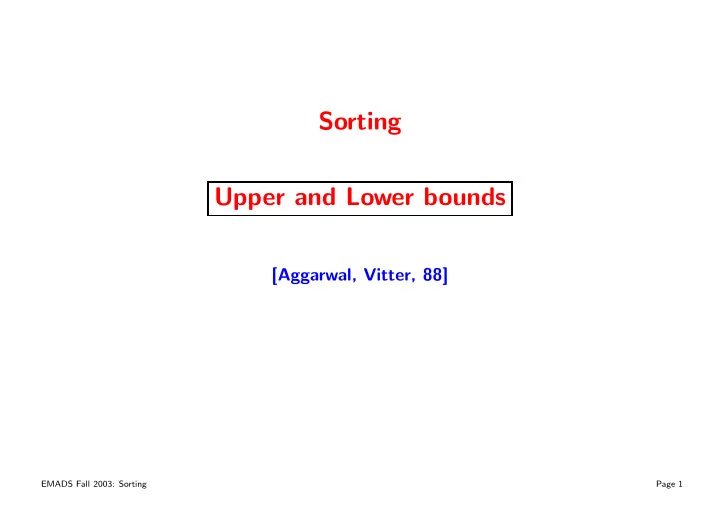

Sorting Upper and Lower bounds [Aggarwal, Vitter, 88] EMADS Fall 2003: Sorting Page 1
Standard MergeSort Merge of two sorted sequences ∼ sequential access · · · · · · · · · MergeSort: O ( N log 2 ( N/M ) /B ) I/Os EMADS Fall 2003: Sorting Page 2
Multiway Merge · · · · · · · · · · · · · · · • For k -way merge of sorted lists we need: M ≥ B ( k + 1) ⇔ M/B − 1 ≥ k • Number of I/Os: 2 N/B . EMADS Fall 2003: Sorting Page 3
Multiway MergeSort • N/M times sort M elements internally ⇒ N/M sorted runs of length M . • Merge k runs at at time, to produce ( N/M ) /k sorted runs of length kM . • Repeat: Merge k runs at at time, to produce ( N/M ) /k 2 sorted runs of length k 2 M , . . . At most log k N/M phases, each using 2 N/B I/Os. Best k : M/B-1. O ( N/B log M/B ( N/M )) I/Os EMADS Fall 2003: Sorting Page 4
Multiway MergeSort 1 + log M/B ( x ) = log M/B ( M/B ) + log M/B ( x ) = log M/B ( x · M/B ) ⇓ O ( N/B log M/B ( N/M )) = O ( N/B log M/B ( N/B )) Defining n = N/B and m = M/B we get Multiway MergeSort: O ( n log m ( n )) EMADS Fall 2003: Sorting Page 5
Sorting Lower Bound Model of memory: RAM Disk · · · • Comparison based model: elements may be compared in internal memory. May be moved, copied, destroyed. Nothing else. • Assume M ≥ 2 B . • May assume I/Os are block-aligned, and that at start, input contiguous in lowest positions on disk. • Adversary argument: adversary gives order of elements in internal memory (chooses freely among consistent answers). • Given an execution of a sorting algorithm: S t = number of permutations consistent with knowledge of order after t I/Os. EMADS Fall 2003: Sorting Page 6
Adversary Strategy After an I/O, adversary must give new answer, i.e. must give order of elements currently in RAM. If number of possible (i.e. consistent with current knowledge) orders is X , then there exist answer such that S t +1 ≥ S t /X. This is because any single answer induces a subset of the S t currently possible permutations (consisting of the permutations consistent with this answer), and the X such subsets clearly form a partition of the S t permutations. If no subset has size S t /X , the subsets cannot add up to S t permutations. Adversary chooses answer fulfilling the inequality above. EMADS Fall 2003: Sorting Page 7
Possible X’s Type of I/O Read untouched block Read touched block Write � M � M � � X B ! 1 B B Note: at most N/B I/0s on untouched blocks. From S 0 = N ! and S t +1 ≥ S t /X we get N ! S t ≥ � t ( B !) N/B � M B Sorting algorithm cannot stop before S t = 1 . Thus, N ! 1 ≥ � t ( B !) N/B � M B for any correct algorithm making t I/Os. EMADS Fall 2003: Sorting Page 8
� ✁ Lower Bound Computation N ! 1 ≥ � t ( B !) N/B � M B � M � t log + ( N/B ) log( B !) ≥ log( N !) B 3 tB log( M/B ) + N log B ≥ N (log N − 1 / ln 2) 3 t ≥ N (log N − 1 / ln 2 − log B ) B log( M/B ) t = Ω( N/B log M/B ( N/B )) a) log( x !) ≥ x (log x − 1 / ln 2) Lemma was used: b) log( x !) ≤ x log x c) log x ≤ 3 y log( x/y ) when x ≥ 2 y y EMADS Fall 2003: Sorting Page 9
Proof of Lemma a) log( x !) ≥ x (log x − 1 / ln 2) Lemma: b) log( x !) ≤ x log x � x � c) log ≤ 3 y log( x/y ) when x ≥ 2 y y √ 2 πx · ( x/e ) x · (1 + O (1 / 12 x )) Stirlings formula: x ! = Proof (using Stirling): √ a) log( x !) ≥ log( 2 πx ) + x (log x − 1 / ln 2) + o (1) log( x !) ≤ log( x x ) = x log x b) � x x y � c) log ≤ log( ( y/e ) y ) = y (log( x/y ) + log( e )) y ≤ 3 y log( x/y ) when x ≥ 2 y EMADS Fall 2003: Sorting Page 10
The I/O-Complexity of Sorting Defining n = N/B m = M/B N/B log M/B ( N/B ) = sort ( N ) we have proven I/O cost of sorting: Θ( N/B log M/B ( N/B )) = Θ( n log m ( n )) = Θ(sort( N )) EMADS Fall 2003: Sorting Page 11
Recommend
More recommend